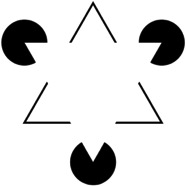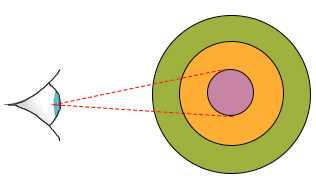In Part one of this Leadership blog I outlined how we actually see with our brains rather than simply with our eyes. So how does that work?
Look up at the sky.
What do you see? If you live in the U.K. there is a good chance your answer is…
Clouds… Lots and lots of clouds.
And if you look a little harder, you might distinguish the outline of a dog, or a fish, or your favourite leader. Our ability to constantly make predictions about the world around us is most obvious when it comes to the visual system. What are the implications of this when it comes to leadership?
In the image below, you will have a vivid impression of a white triangle hanging on top of a black triangle and three circles. You can almost see the ‘white’ line that traces the triangle’s edges, even in the sections where it crosses the white background.
If you look closely enough at those sections the illusion disappears.

The source of this illusion is the same reason we have survived the eras in which wild predators were a daily concern for us. In the image below you see a unified creature hanging behind those trees, not a scattered set of harmless body parts. Our subconscious is always trying to predict and categorize the objects around us.

We can develop great skill in predicting motion as well as imagery.
In baseball, a 100 mph pitch takes only 0.4 seconds to get to the batter. There is at least a 0.1 second delay between your eyes ‘seeing’ the ball and your brain registering it, leaving only 0.3 seconds, at best, to hit a tiny 7 cm ball that may not be flying straight.
Such a feat is impossible unless the brain was doing some serious calculations to predict the position of the ball even before it leaves the pitchers hands (if you think 0.3 seconds is plenty of time, go ahead and try to ‘start and stop’ a timer in just 0.3 seconds…).
There is even evidence we are constantly predicting peoples next words. This makes sense give people’s propensity for finishing others’ sentences; occasionally they want to show they know where they are going with their thought. This can be quite romantic if it’s with a partner perhaps, less so when you keep getting interrupted in a meeting (our assertiveness course can help with that).
Prediction leads to mental models
Your view of the world is a complex fabrication.
I mean that both figuratively and literally.
Again I will start with a visual example. Most of us have the impression that our vision is a unified and continuous stream of information from everything we see before us.
Yet, this cannot be the case. The area of our eye that can perceive in high definition can only take in a field of view of 1-2 degrees, or about the area of your thumb at arm’s length.
Anything outside of that area quickly becomes less defined as shown in the diagram. Beyond that we have peripheral vision which is capable of perceiving some shapes, contrast, and movement.

To complicate matters our eyes, even when fixating on a single point in space, do not stay still, they jump around in tiny movements called saccades. If we were taking in unfiltered visual information it would be like an erratic, twitchy, tunnel vision jumping from position to position every fourth of a second.
Thankfully our brain integrates all of the information available to it (from the recent past, the present focus, and its predictions) and creates a mental model of the landscape to fill in the gaps that our senses cannot cover (on another note, if its your ‘vision’ for the future of your business that you want to expand, our strategic planning course is a great option).
The easies example of this ‘filling in’ is our blind spot, which we do not notice in normal vision until we look at the picture below. To test it, close your left eye, fixate your right eye on the ‘X’ and slowly move closer to the screen until the triangle disappears from your peripheral vision. It should reappear if you get close enough.
How easy is it to describe the different colours and triangle shape without sneaking a peek directly at it?
![]()
Models of other minds
Vision is just one very concrete illustration.
The predictions we make about what people will say also create quite vivid models of other people’s minds!
By about five years of age most children develop a ‘Theory of Mind’, or the ability to attribute thoughts and beliefs to people and distinguishing them from their own thoughts and beliefs. The younger the child the more they will assume that what they think and feel, everyone else also thinks and feels at the same time.
In adulthood we sometimes go to the opposite end of the spectrum and not only distinguish minds, but also act as though we can read them! Often (but not always), just like the visual effects we saw above, the mind reading ability is an illusion.
We make assumptions about what people are thinking without ever checking our intuition. It is as though we see the person in our peripheral vision and assume we can see every detail without actually directing our gaze in their direction.
A glimmer of hope – are we not alone?
If our perception is not as it seems, and we automatically create these models that may not represent reality, are we really doomed to be “alone the whole way”?
I think the general conclusion we can make from the science is: NO!
(Whoever said science was heartless?)
In spite of the imperfections in our models, both visual and of other minds, the ability to assess the present moment and make predictions about the future allow for something amazing to happen.
Synchrony
Our brains all have the same basic structure and each area of the brain functions roughly in the same way. This means that, under the right conditions, the electrical patterns between the brains of two people can be created in the same areas of the brain and at the same time, leading to synchronization of the brain waves.
The clearest example of this comes from studies looking at the brains of musicians. While playing a duet, the electrical impulses from two guitarists’ brains were activating the same areas and occurring at the same time. The process of actively listening to each other, and modifying their playing accordingly, led to synchronisation of their brains as well as that of their music.
Why is that important?
I think it is safe to conclude that if two brains (which are similar in function) activate the same brain areas in a synchronized way it is likely the two individuals are having, at the very least, a similar experience.
But maybe this isn’t too surprising given music has a beat? Does this happen in regular conversations too?
Turns out the answer is ‘yes’ and it happens all the time. You can literally be on the same wavelength as the person you are talking with. When you have that feeling that you just ‘click’ with someone chances are your brain waves are actually synchronised. The similarity of brain patterns suggest you also have similar thinking patterns, making it easier to process information and understand each other in a deeper way.
Seamless leadership communication
Imagine a level of seamless communication where every word and sentence is understood by the listener exactly as the speaker intended. In this state, out of the myriad of interpretations that often exist in our ambiguous language, we pick the right one every time.
That feeling of connection could not be any more real! You are not alone after all!
This has been quite a journey. For a summary of the ideas in part one and two of this blog please see part three (coming soon).


Leave a comment